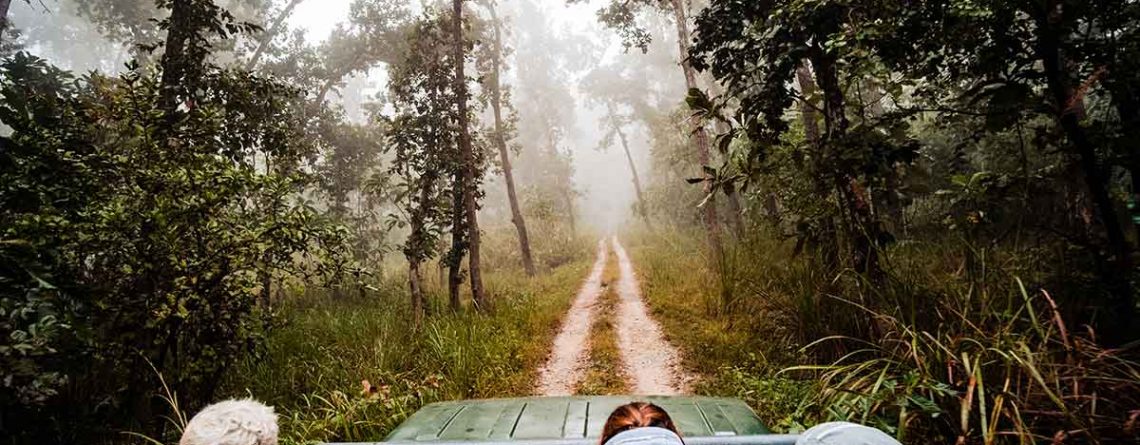Visiting CHITWAN – the SOUL of wild Nepal
One of the must-see places of Nepal, Chitwan is a big draw with its luxury lodges and Jungle safaris! Chitwan – meaning ‘Heart of the jungle’, it is famous for its one-horned Rhinos and the Royal Bengal Tiger (though sightings are very quite rare).
I was looking forward to the day long forest walks – one of the few National Parks in South Asia, which allow this; though you have to come out of the park by the end of the day.
Getting to Sauraha (the northern bank of the Rapti River – which borders the Park) from Lumbini was a complicated affair though – one bus, local van and then a six seater to your lodge. Anna and Hector – two fellow back-packer tourists were fortunate enough to tag along with someone who could speak Hindi and figure out the route to Sauraha!
I stayed at Chitwan Gaida Lodge – recommended for a birder by Lonely planet and how apt was that! Owned by Mr. Tika Ram Giri, a well-known field ornithologist in Nepal, this place is very beautiful – basic and semi-luxurious – but a great value for money and of course, the hospitality and the quality of the naturalists is quite good. I had the opportunity of meeting Tika Ram himself and to get blown away by his humble, but self-assured and immense knowledge about birds! After helping with my bird identifications of species seen during my forest walk, Tika Ram bowled me over by even mentioning the places inside the forest –where I had seen the birds! In his own words, he knows every inch of Chitwan!
Yes, you do the safaris like every other tourist – longing for a sight of the elusive tiger. But the highlight of my trip was undisputedly the forest walk – a day-long adventure along with the two guides (mandatory) – Kisna and Iswari Prasad. We started with the Canoe ‘safari’ – which was quite rewarding with at least 45 bird species in the span of 1 hour. We had to end the canoe-ride abruptly before starting the walk – due to the nonchalant raucous presence of the bathing rhino in the middle of the river.
Exhilarating, to say the least! Walking leisurely, tracking down birds – many of which were ‘lifers’ (first time sights) for me, surprising Sloth bears (quite dangerous in fact), excitedly looking at tiger pug marks, lunch (packed) in the forest – all in a day’s work! Never felt tired in the least! Being one with pure nature, in the forests – one of the best pleasures of my life; birding is but an excuse!
Will remember this part of my Nepal trip very fondly! Ended with 87 bird species spotted with 15 lifers.
Just the list of birds that I have listed down here should be compelling enough to give your much awaited visit to Nepal and Chitwan National park a thought. Isnt it?
The list of birds spotted (and identified with the help of Iswari Prasad and Tika Ram)
- Lesser Whistling-Duck (Dendrocygna javanica)
- Ruddy Shelduck (Tadorna ferruginea)
- Gadwall (Anas strepera)
- Goosander (Mergus merganser)
- Indian Peafowl (Pavo cristatus)
- Red Junglefowl (Gallus gallus)
- Asian Openbill (Anastomus oscitans)
- Woolly-necked Stork (Ciconia episcopus)
- Lesser Adjutant (Leptoptilos javanicus)
- Little Cormorant (Microcarbo niger)
- Great Cormorant (Phalacrocorax carbo)
- Oriental Darter (Anhinga melanogaster)
- Grey Heron (Ardea cinerea)
- Great White Egret (Ardea alba)
- Intermediate Egret (Mesophoyx intermedia)
- Little Egret (Egretta garzetta)
- Indian Pond Heron (Ardeola grayii)
- Striated Heron (Butorides striata)
- Red-naped Ibis (Pseudibis papillosa)
- Black-winged Kite (Elanus caeruleus)
- Crested Serpent-Eagle (Spilornis cheela)
- Grey-headed Fish-Eagle (Ichthyophaga ichthyaetus)
- White-breasted Waterhen (Amaurornis phoenicurus)
- Grey-headed Swamphen (Porphyrio poliocephalus)
- Common Moorhen (Gallinula chloropus)
- Eurasian Coot (Fulica atra)
- River Lapwing (Vanellus duvaucelii)
- Red-wattled Lapwing (Vanellus indicus)
- Little Ringed Plover (Charadrius dubius)
- Green Sandpiper (Tringa ochropus)
- Common Greenshank (Tringa nebularia)
- Spotted Dove (Streptopelia chinensis)
- Asian Emerald Dove (Chalcophaps indica)
- Greater Coucal (Centropus sinensis)
- Lesser Coucal (Centropus bengalensis)
- Green-billed Malkoha (Phaenicophaeus tristis)
- Jungle Owlet (Glaucidium radiatum)
- Oriental Pied-Hornbill (Anthracoceros albirostris)
- Common Kingfisher (Alcedo atthis)
- White-throated Kingfisher (Halcyon smyrnensis)
- Pied Kingfisher (Ceryle rudis)
- Green Bee-eater (Merops orientalis)
- Coppersmith Barbet (Psilopogon haemacephalus)
- Lineated Barbet (Psilopogon lineatus)
- Lesser Yellownape (Picus chlorolophus)
- Greater Yellownape (Picus flavinucha)
- Black-rumped Flameback (Dinopium benghalense)
- Collared Falconet (Microhierax caerulescens)
- Plum-headed Parakeet (Psittacula cyanocephala)
- Red-breasted Parakeet (Psittacula alexandri)
- minivet sp. (Pericrocotus sp.)
- Large Cuckooshrike (Coracina macei)
- Long-tailed Shrike (Lanius schach)
- Black-hooded Oriole (Oriolus xanthornus)
- Black Drongo (Dicrurus macrocercus)
- Crow-billed Drongo (Dicrurus annectans)
- White-throated Fantail (Rhipidura albicollis)
- Rufous Treepie (Dendrocitta vagabunda)
- Large-billed Crow (Corvus macrorhynchos)
- Grey-throated Martin (Riparia chinensis)
- swallow sp. (Hirundinidae sp.)
- Yellow-bellied Fairy-Fantail (Chelidorhynx hypoxantha)
- Cinereous Tit (Parus cinereus)
- Black-crested Bulbul (Pycnonotus flaviventris)
- Red-vented Bulbul (Pycnonotus cafer)
- Red-whiskered Bulbul (Pycnonotus jocosus)
- Black Bulbul (Hypsipetes leucocephalus)
- Greenish Warbler (Phylloscopus trochiloides)
- Phylloscopus sp. (Phylloscopus sp.)
- Common Tailorbird (Orthotomus sutorius)
- Chestnut-capped Babbler (Timalia pileata)
- Pin-striped Tit-Babbler (Mixornis gularis)
- Jungle Babbler (Turdoides striata)
- Oriental Magpie-Robin (Copsychus saularis)
- Siberian Stonechat (Saxicola maurus)
- White-tailed Stonechat (Saxicola leucurus)
- Pied Bushchat (Saxicola caprata)
- Black-throated Thrush (Turdus atrogularis)
- Common Hill Myna (Gracula religiosa)
- Asian Pied Starling (Gracupica contra)
- Common Myna (Acridotheres tristis)
- Jungle Myna (Acridotheres fuscus)
- Citrine Wagtail (Motacilla citreola)
- Pied Wagtail/White Wagtail (Motacilla alba)
- White-browed Wagtail (Motacilla maderaspatensis)
- Upland Pipit (Anthus sylvanus)
- House Sparrow (Passer domesticus)






Leave a Reply